
The Majestic Temple of Saturn
Explore the Temple of Saturn, an emblem of ancient Rome's rich history and architectural brilliance, located in the heart of the Parco Archeologico del Colosseo.
Discover the grandeur of the Temple of Saturn, a historical gem in the heart of Rome. This ancient site captivates visitors with its rich history, stunning architecture, and fascinating archaeological significance. A must-see for every traveler.
A brief summary to Temple of Saturn
- Parco archeologico del Colosseo, Rome, Metropolitan City of Rome Capital, 00186, IT
- +390669984443
- Visit website
- Monday 9 am-7:15 pm
- Tuesday 9 am-7:15 pm
- Wednesday 9 am-7:15 pm
- Thursday 9 am-7:15 pm
- Friday 9 am-7:15 pm
- Saturday 9 am-7:15 pm
- Sunday 9 am-7:15 pm
Local tips
- Visit early in the morning to avoid crowds and enjoy a more peaceful experience.
- Consider combining your visit with nearby attractions like the Roman Forum and the Colosseum for a full day of exploration.
- Bring a camera to capture the stunning architecture and breathtaking views of the ruins.
- Check the opening hours before your visit, as they may vary seasonally.
- Wear comfortable shoes, as the site involves a fair amount of walking over uneven surfaces.
Getting There
-
Walking
If you are starting from the Colosseum, walk towards the Colosseum Metro Station (Metro Line B). Exit the station and head towards Via di San Gregorio. Continue walking straight until you reach the intersection with Via dei Serpenti, then turn left. Walk straight until you see the entrance to the Parco archeologico del Colosseo on your right. The Temple of Saturn is located within the park.
-
Walking
If you are at the Roman Forum, exit the Forum and walk towards Via della Salara Vecchia. Continue straight until you reach the entrance of the Parco archeologico del Colosseo. The Temple of Saturn will be within the park area.
-
Bus
Take Bus number 75 or 81 from any nearby bus stop to the 'Colosseo' stop. Once you get off, head towards the Colosseum. From there, follow the walking directions provided above to reach the Temple of Saturn.
-
Metro
Take Metro Line B to 'Colosseo' station. Exit the station and walk towards the Colosseum. Follow the walking directions provided above to reach the Temple of Saturn located in the Parco archeologico del Colosseo.
Discover more about Temple of Saturn
Iconic landmarks you can’t miss
Temple of Vespasian and Titus
0.0 km
Discover the historical beauty of the Temple of Vespasian and Titus, a significant landmark in the heart of Rome that showcases ancient Roman architecture.

Roman Forum
0.1 km
Discover the rich history and majestic ruins of the Roman Forum, a must-visit archaeological site in the heart of ancient Rome.

Statue of Julius Caesar
0.2 km
Discover the rich history of Rome through the iconic Statue of Julius Caesar, a must-see landmark that celebrates the legacy of one of history's greatest leaders.

Ancient Church of Saint Mary
0.2 km
Discover the Ancient Church of Saint Mary in Rome, a serene oasis filled with history, art, and spiritual beauty, perfect for every traveler.

Largo Romolo e Remo
0.2 km
Discover the charm of Largo Romolo e Remo, a hidden historical landmark in Rome that showcases the city's rich cultural heritage and vibrant atmosphere.

Monument Cola Di Rienzo
0.2 km
Explore the Monument to Cola Di Rienzo, a historical gem in Rome celebrating civic pride and justice amidst the city's rich heritage.

Ara Coeli Staircase
0.2 km
Discover the breathtaking Ara Coeli Staircase in Rome, where history, art, and panoramic views converge in a magnificent ascent.

Terrazza delle Quadrighe
0.2 km
Discover stunning panoramic views of Rome from the iconic Terrazza delle Quadrighe, a must-visit observation deck in the heart of the city.

House of the Vestals
0.2 km
Discover the ancient secrets of the House of the Vestals in the heart of Rome, where history and mystery intertwine in stunning ruins.

Insula Romana
0.2 km
Discover the remarkable history of Insula Romana, where ancient Roman life comes alive through well-preserved ruins in the heart of Rome.

Parco archeologico del Colosseo
0.2 km
Discover the grandeur of ancient Rome at Parco Archeologico del Colosseo, where history, architecture, and culture converge in breathtaking ruins.

Monument to Victor Emmanuel II
0.2 km
Explore the Monument to Victor Emmanuel II in Rome, a grand symbol of Italian unity with stunning architecture and panoramic city views.

Via dei Fori Imperiali
0.3 km
Discover the stunning history and breathtaking views along Via dei Fori Imperiali, Rome's iconic street filled with ancient ruins and vibrant atmosphere.

Trajan's Forum
0.3 km
Explore Trajan's Forum in Rome, a historic landmark that showcases the grandeur of ancient Roman architecture and its fascinating history.

Altare della Patria
0.3 km
Explore the Altare della Patria, an iconic monument in Rome celebrating Italian unity with breathtaking views and rich historical significance.

Unmissable attractions to see
Milliarium Aureum
0.0 km
Explore the Milliarium Aureum, the iconic milestone of ancient Rome, and immerse yourself in the rich history of the Eternal City.

Umbilicus Urbis
0.0 km
Discover the Umbilicus Urbis, the historical heart of Rome, where ancient history comes alive through captivating ruins and rich cultural heritage.
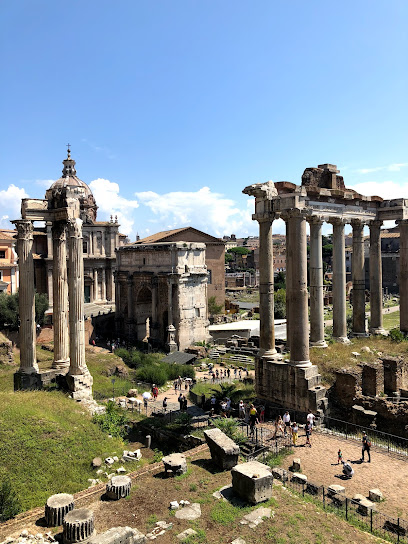
Septimius Severus Arch
0.1 km
Explore the Septimius Severus Arch, an iconic triumphal arch in Rome showcasing the grandeur of the ancient Roman Empire through its intricate carvings and rich history.

Lapis Niger
0.1 km
Discover the Lapis Niger, a historical landmark in Rome that reveals the city's ancient secrets and the legendary roots of its foundation.

Lacus Curtius
0.1 km
Explore Lacus Curtius, a remarkable ancient site in Rome, steeped in myth and history, located adjacent to the iconic Roman Forum.

Senatorial Palace
0.1 km
Discover the rich political history of Rome at the Senatorial Palace, a stunning historical landmark in the heart of the Eternal City.

Basilica Julia
0.1 km
Discover the architectural splendor and historical significance of Basilica Julia, a must-see gem in the heart of Rome's ancient forum.
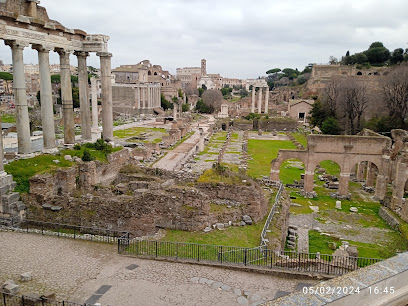
Mamertine Prison
0.1 km
Explore the haunting history of Mamertine Prison, an archaeological gem in Rome where notorious figures faced their fate in ancient times.

Equestrian Statue of Domitian (Equus Domitiani)
0.1 km
Discover the Equestrian Statue of Domitian, a historical landmark in Rome showcasing the artistry and grandeur of the Roman Empire's imperial legacy.

Curia Iulia
0.1 km
Explore Curia Iulia, the ancient Senate House of Rome, and immerse yourself in the rich history of the Roman Republic amidst stunning archaeological surroundings.

Fountain of the Goddess Roma
0.1 km
Discover the Fountain of the Goddess Roma, a stunning masterpiece in Piazza del Campidoglio, embodying the rich history and beauty of the Eternal City.

Lupa Capitolina
0.1 km
Discover the Lupa Capitolina, a legendary symbol of Rome's foundation and a captivating historical sculpture in the heart of the Eternal City.

Equestrian Statue of Marcus Aurelius
0.1 km
Explore the Equestrian Statue of Marcus Aurelius in Rome, a stunning monument reflecting ancient wisdom and artistry at the heart of the city.
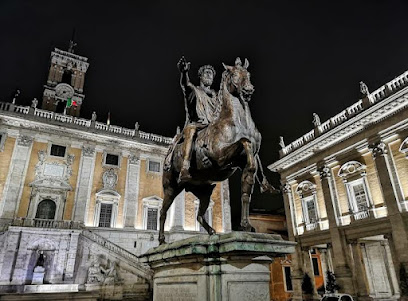
Capitoline Hill
0.1 km
Discover the rich history and breathtaking views at Capitoline Hill, a must-visit destination in the heart of Rome's ancient landscape.

Capitoline Museums
0.1 km
Explore the Capitoline Museums, a captivating fusion of art, history, and architecture nestled in the heart of Rome, showcasing the city's rich cultural heritage.

Essential places to dine
In Roma - since 1917
0.2 km
Discover authentic Italian flavors at In Roma - where tradition meets culinary excellence in the heart of Rome.

Unique Al Palatino Garden Restaurant
0.3 km
Experience authentic Italian cuisine amidst lush gardens at Unique Al Palatino Garden Restaurant in Rome.

Ristorante Roof Garden
0.3 km
Experience exquisite Italian cuisine with breathtaking views at Ristorante Roof Garden in the heart of Rome.
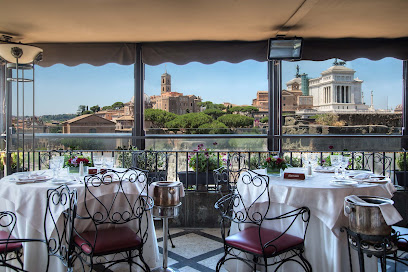
La Taverna dei Fori Imperiali
0.4 km
Experience authentic Italian cuisine at La Taverna dei Fori Imperiali in Rome – where tradition meets flavor in every dish.

Iari The Vino
0.4 km
Experience authentic Italian cuisine at Iari The Vino in Rome - home to exquisite ravioli and warm hospitality.

Ristorante Ad hoc
0.5 km
Experience authentic Italian cuisine at Ristorante Ad hoc in Rome – where every meal is a celebration of flavor and tradition.

Hedera - Osteria Contemporanea
0.6 km
Experience modern Italian cuisine at Hedera - Osteria Contemporanea in Rome; a perfect blend of tradition and innovation awaits you.

Ce Stamo A Pensà
0.6 km
Experience authentic Southern Italian cuisine at Ce Stamo A Pensà in Rome—where every dish tells a story.

Ristorante il Buco Roma
0.7 km
Experience authentic Tuscan flavors at Ristorante il Buco in Rome—where tradition meets taste.

Hostaria da Nerone
0.7 km
Experience the essence of Rome at Hostaria da Nerone with authentic dishes that celebrate Italy's rich culinary heritage.

Sphaeristerium
0.7 km
Experience authentic Italian flavors at Sphaeristerium - where tradition meets culinary excellence in the heart of Rome.

La Ciambella
0.8 km
Discover authentic Italian cuisine at La Ciambella in Rome - where every dish celebrates the rich flavors of Italy.

Da Nina a Trastevere
0.8 km
Discover authentic Sicilian cuisine at Da Nina a Trastevere—where every dish tells a story in the heart of Rome.

Roma Sparita
0.8 km
Experience authentic Roman cuisine at Roma Sparita in Trastevere—home to iconic dishes like Cacio e Pepe amidst charming surroundings.

Ristorante Puntarella
0.8 km
Experience authentic Roman cuisine at Ristorante Puntarella – where tradition meets taste in the heart of Rome.

Markets, malls and hidden boutiques
Souvenir Roma
0.5 km
Discover exquisite gifts and authentic Italian souvenirs at Souvenir Roma, the ultimate stop for tourists in Rome.

Boutique dei Serpenti - Borse e Bijoux Roma
0.6 km
Explore Boutique dei Serpenti in Rome for exquisite Italian handbags and jewelry, showcasing unique craftsmanship and timeless style.

PODERE VECCIANO
0.6 km
Discover authentic Italian flavors and exquisite wines at Podere Vecciano, the charming supermarket and grocery store in the heart of Rome.

Pifebo Vintage Shop
0.6 km
Explore Pifebo Vintage Shop in Rome for unique vintage clothing and accessories, where every piece tells a story of timeless fashion.

King Size Vintage
0.6 km
Shop unique vintage clothing at King Size Vintage in Rome, where every piece has a story and timeless style awaits.

SUFIR
0.7 km
Discover SUFIR in Rome: your ultimate destination for exquisite leather goods, handcrafted handbags, and stylish dresses.

The Oliver wardrobe
0.7 km
Discover unique vintage and baby clothing at The Oliver Wardrobe, a charming used clothing store in the heart of Rome.

Blue Goose
0.7 km
Explore a vintage clothing haven in Rome's heart, where every piece tells a story and fashion meets history.

Kokoro
0.7 km
Explore Kokoro, a chic women's clothing boutique in Rome, showcasing unique styles and quality fashion for every occasion.

Pulp vintage
0.7 km
Discover timeless fashion treasures at Pulp Vintage, a unique clothing store in the heart of Rome, where each piece tells a story.

Hang Roma - Unconventional Leather Bags Handmade in Rome - Borse e Accessori In cuoio
0.8 km
Discover the charm of Italy through exquisite handmade leather goods at Hang Roma, a premier destination for fashion enthusiasts and souvenir hunters alike.

Open Door Bookshop
0.8 km
Discover the charm of Rome through literature at Open Door Bookshop, a cozy haven for book lovers in the heart of Trastevere.

M Delavari Pelletteria Roma
0.8 km
Explore exquisite Italian leather craftsmanship at M Delavari Pelletteria in Rome, offering handcrafted bags, wallets, and accessories for discerning travelers.
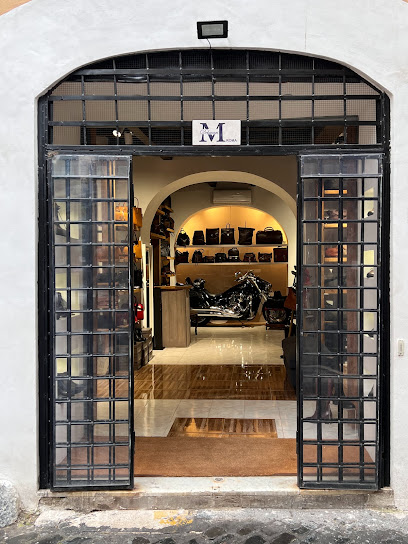
Souvenirs Shop - Best Price Souvenirs in Rome
0.8 km
Discover authentic Italian souvenirs at the Best Price Souvenirs Shop in Rome, where quality meets affordability in every unique find.
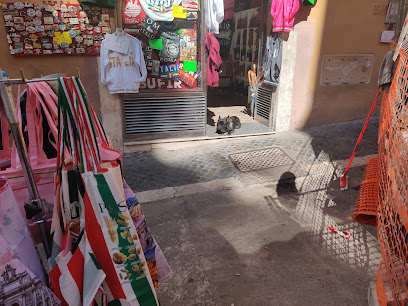
Souvenir fountain
0.8 km
Discover the essence of Rome at Souvenir Fountain, where unique keepsakes and local artistry come together to create unforgettable memories.

Essential bars & hidden hideouts
Shamrock
0.4 km
Experience the charm of an Irish pub in Rome, where delicious food, refreshing drinks, and a lively atmosphere await you near the Colosseum.

Otivm Roof Bar
0.4 km
Discover the enchanting Otivm Roof Bar, where exquisite cocktails meet breathtaking views in the heart of Rome's vibrant nightlife.

Ice Club Roma
0.4 km
Experience the coolest nightlife at Ice Club Roma, where unique cocktails and vibrant parties await you in the heart of the Eternal City.

Ex Galleria
0.4 km
Discover the perfect fusion of cocktail culture and contemporary art at Ex Galleria, Rome's hidden gem for an unforgettable night out.

Caffè Roma
0.6 km
Experience the charm of Caffè Roma - a cozy coffee shop near the Colosseum, perfect for a delightful break in Rome.

The Hole Trastevere
0.7 km
Discover the vibrant nightlife of Trastevere at The Hole, a cocktail bar blending creative drinks and local culture in the heart of Rome.

Oppio Caffè
0.7 km
Experience the authentic taste of Italy at Oppio Caffè, a delightful café in Rome offering exquisite dishes, refreshing cocktails, and a vibrant atmosphere.

Ri.ONE RoofTop Cocktail bar
0.8 km
Discover the best views and unique cocktails at Ri.ONE RoofTop Cocktail Bar, your perfect escape in the heart of Rome, Italy.

404 Name Not Found
0.8 km
Experience the vibrant cocktail culture at 404 Name Not Found Cocktail Bar, a stylish gem in the heart of Rome, perfect for unwinding and socializing.

Santa Cocktail Club - Roma
0.8 km
Discover Santa Cocktail Club in Rome, where innovative cocktails and vibrant nightlife create unforgettable memories in the heart of the Eternal City.
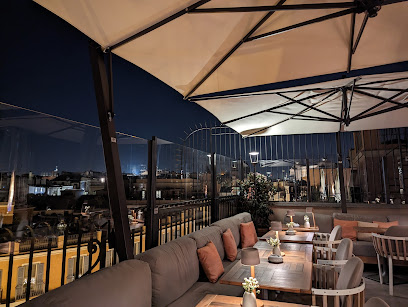
Coming Out
0.9 km
Discover the vibrant atmosphere of Coming Out, a renowned gay bar and restaurant in Rome, where inclusivity and nightlife come together.

RoofTop Lounge Trevi
0.9 km
Discover the breathtaking views and exquisite cocktails at RoofTop Lounge Trevi, a premier destination for tourists in Rome.

Blackmarket Hall
0.9 km
Discover Blackmarket Hall: A vibrant cocktail bar and bistro in Rome offering delicious food, exquisite cocktails, and live music in a lively atmosphere.

Goodness Food & Wine Roma
0.9 km
Experience the finest Italian wines and authentic cuisine at Goodness Food & Wine Roma, where every sip and bite tells a story.
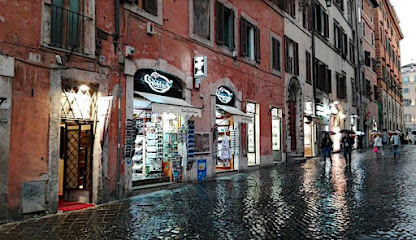
Bar Fontana di Trevi
0.9 km
Discover the delightful Bar Fontana di Trevi, a charming spot for gelato and drinks near Rome's iconic Trevi Fountain.




